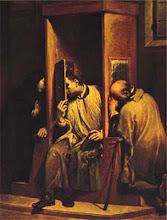Not much is known of Clement's life. According to Tertullian, writing in A.D. 199, the Roman Church claimed that Clement was ordained by St. Peter. Although there is some discrepancy in the ancient literature, the Church generally acknowledges Saint Clement as the third ruler of the Roman Church after Saint Peter.
Starting in the 3rd and 4th century, tradition has identified him as the Clement that Paul mentions in Philippians 4:3 as a fellow laborer in Christ.
The Liber Pontificalis, which documents the reigns of popes, states that Clement had known Saint Peter. It also states that he wrote two letters (though the second letter, 2 Clement, is no longer ascribed to him) and that he died in Greece in the third year of Emperor Trajan's reign, or 101 AD.
According to apocryphal acta, dating to the 4th century at earliest, Clement was banished from Rome to the Chersonesus (Crimea) during the reign of the Emperor Trajan and was set to work in a stone quarry. Finding on his arrival that the prisoners were suffering from lack of water, he knelt down in prayer. Looking up, he saw a lamb on a hill, went to where the lamb had stood and struck the ground with his pickaxe, releasing a gushing stream of clear water. This miracle resulted in the conversion of large numbers of the local pagans and his fellow prisoners to Christianity. As punishment, Saint Clement was martyred by being tied to an anchor and thrown from a boat into the Black Sea. The legend recounts that every year a miraculous ebbing of the sea revealed a divinely built shrine containing his bones. However, the oldest sources on Clement's life, Eusebius and Jerome, note nothing of his martyrdom.
The Inkerman Cave Monastery marks the supposed place of Clement's burial in the Crimea. A year or two before his own death in A.D. 869, Saint Cyril brought to Rome what he believed to be the relics of Saint Clement, bones he found in the Crimea buried with an anchor on dry land. They are now enshrined in the Basilica di San Clemente. Other relics of Saint Clement, including his head, are claimed by the Kiev Monastery of the Caves in Ukraine.
Saint Clement is also the only Pope to have a Russian Orthodox church dedicated to him.
Saint Clement Church, Pyatnitskaya Street, Moscow
The First Epistle of Clement is a letter of Saint Clement to the faithful in Corinth, where certain of the clergy there had been deposed, apparently without moral cause. Saint Clement calls for repentance the reinstatement of the clergy in his letter to the faithful, which was read, along with the Scriptures, to the faithful in Corinth beginning in A.D. 170. Although not a part of the Bible properly, the reading of the First Epistle of Clement by the fourth century had also spread to other churches.
Prayer
All-powerful and ever-living God,
we praise your power and glory
revealed to us in he lives of all your saints.
Give us joy on this feast of Saint Clement,
the priest and martyr
who bore witness with his blood o the love he proclaimed
and the gospel he preached.
We ask this through our Lord Jesus Christ, your Son,
who lives and reigns with you and the Holy Spirit,
one God, for ever and ever.
Amen.














No comments:
Post a Comment